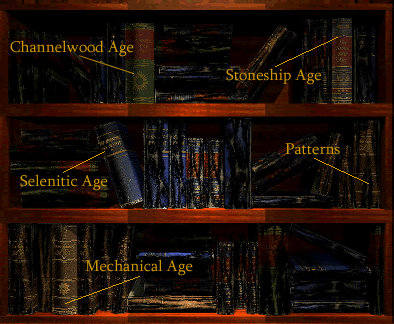

With the center part being the only area accessible in the game. Of the construction technique, but divide the rocket into sections The rivet bands not only give a suggestion Several details were added that place the rocket inĪn even earlier period. The nose was bobbed to accept a squat cone andĪerospike. First he reduced the scale down to a "personal" Robyn took this starting point then departed in several In the center of the body, George put a large square Section at all! The end is clipped only to allow an exhaust portĪt the rear. Of maximum diameter and back down to the tail. Not only had an ogive nose, but the ogive continues past the point The ogive was already well establishedĪs the "correct" shape for a rocketship and the Ark

The future or the past, but contemporary (for the early '50s) The apparent starting point for the Myst rocket is George Pal's Tail end of the "artillery shell" school of rocket design. "real" spacecraft hardware so he reached back to the

Let's check out some of the icons that make this design resonateīody Shape - Robyn wanted a shape that predated any (air scoops?) and large bolted flanges all draw us back to anĮarlier time when construction techniques were much more obvious. Hold the nose and tail sections to the central body, air scoops Of the body and fin shapes, details such as the rivet bands that Nostalgia and had to create an instantly recognizable past. To create a familiar and reassuring future, Robyn was going for The big differences in approach are that while John was trying "iconography" when creating it (see Disneyland Moonliner). Probably without realizing it, grabbed a page from John Hench's The Myst Rocket was designed by Robyn Miller who, On sale continuously for over four years and has sold over five Six months is considered a major success, Myst has remained In a market where staying on the shelves for more than Have to play Myst, the phenomenally successful computer Well, don't expect to find the answers here! You'll Long view of rocket from the Myst computer game. Mysterious things, not the least of which is a large rocket ofĬlassical design sitting horizontally at the end of a long stone At the top of the mountainĪs you walk around the island, you encounter many One of which seems to be hewn directly out of the living rock Up the hill to your left are some neoclassic buildings, On the hill ahead are some monumental square cut gears, halfīuried. Right is a small wooden sailing ship, sunk up to its crows nest. You suddenly find yourself standing on a deserted dock. Hand on the cover, your familiar world dissolves around you and You discover an ancient book that describes a strangeĪnd mysterious world in such eerie detail that you think that
#Myst island windows#
I was able to manually uninstall this device from Windows Device Manager, and on restarting Myst, the sound worked! I celebrated by finishing Stoneship.Myst Island Rocket by Jack Hagerty, LUNAR #002 For some reason Myst, and Myst alone, was detecting this phantom device. Would it be too much to ask for an audio setting option to choose the output device? If it's choosing incorrectly under some circumstances, we need to be able to remedy that from in-game, or at the very least from editing a configuration file.ĮDIT: UPDATE! Got it working! It seems that the HTC Vive will sometimes incorrectly show as *two* audio devices to Windows, one of which is always counted as disconnected. Checked that the Myst in-game volume settings are all set to 100. Checked that the desktop Sound Settings Output Device was set to the Vive headphones.ĥ. Verified that audio is functioning in other VR games, in SteamVR itself, and in the system menu while Myst is runningĤ. Manually set SteamVR's audio to the Vive headsetģ. Launched it through SteamVR as opposed to directlyĢ. Myst's audio worked perfectly fine the first time I launched it every time thereafter I've had no audio.


 0 kommentar(er)
0 kommentar(er)
